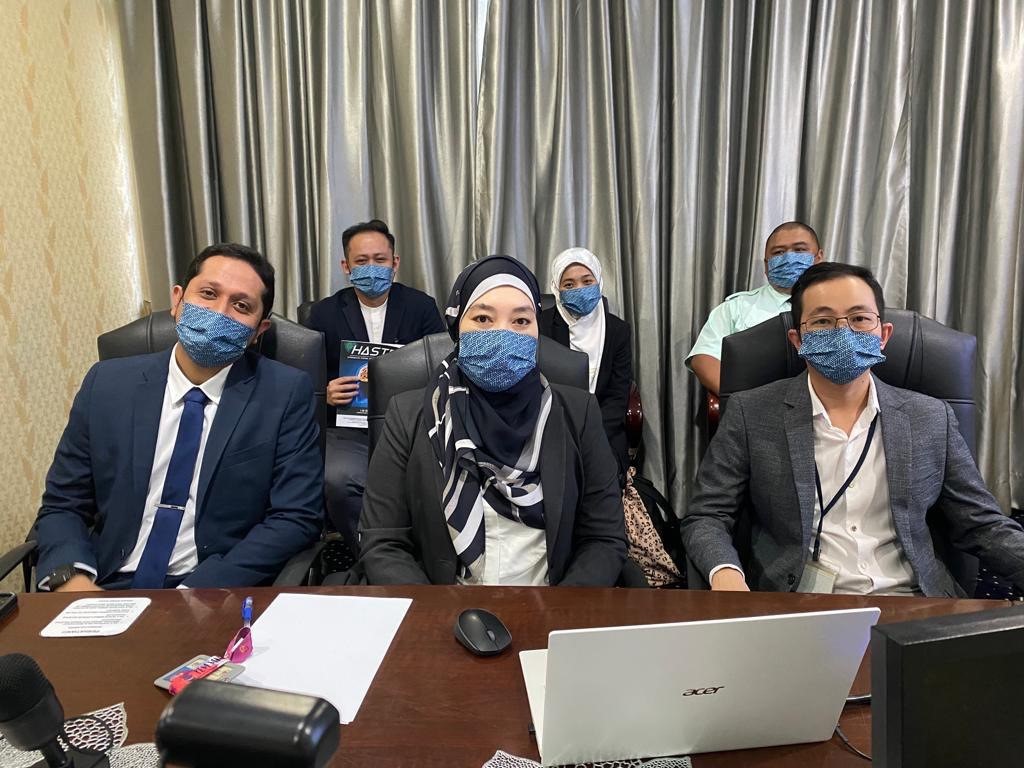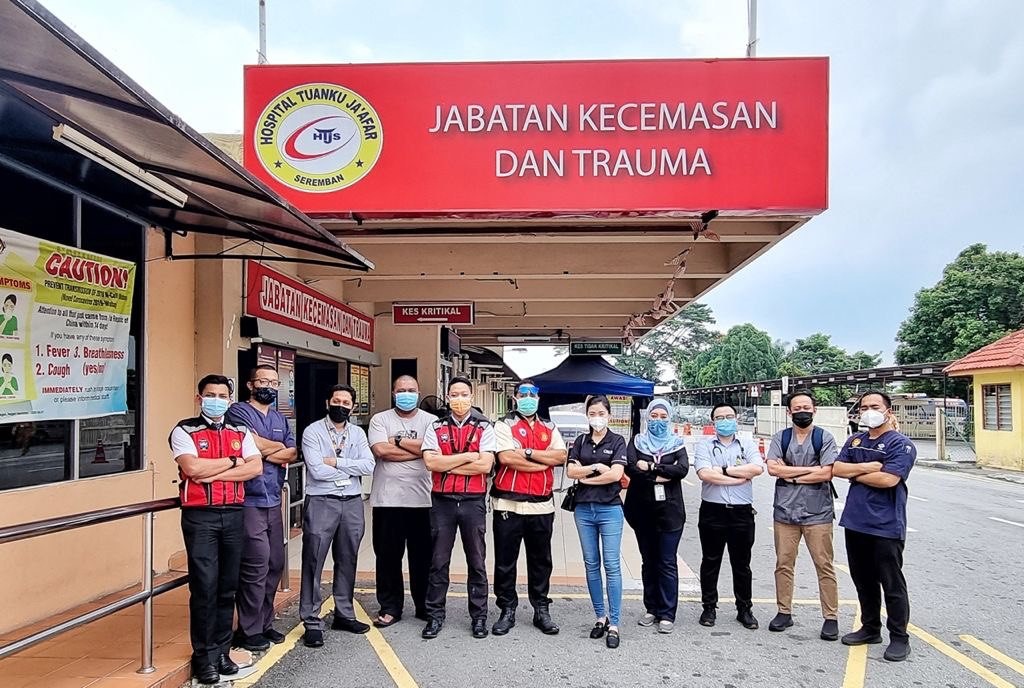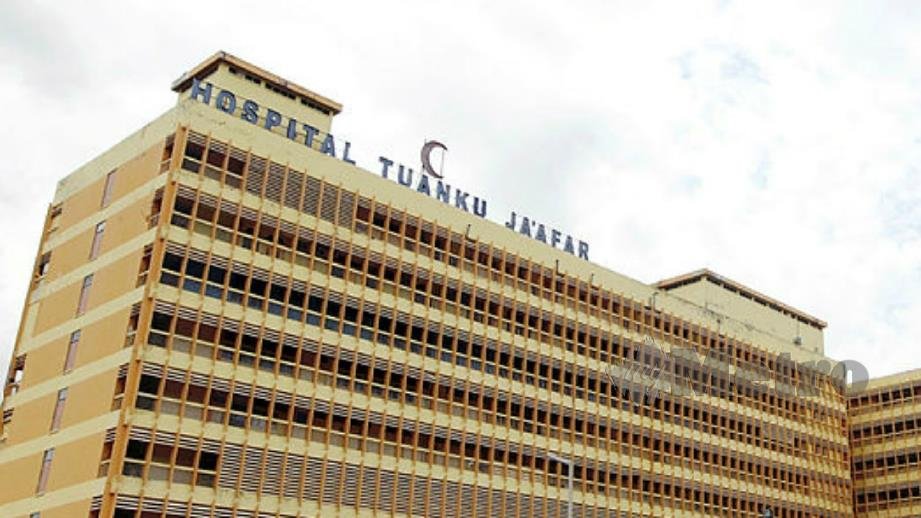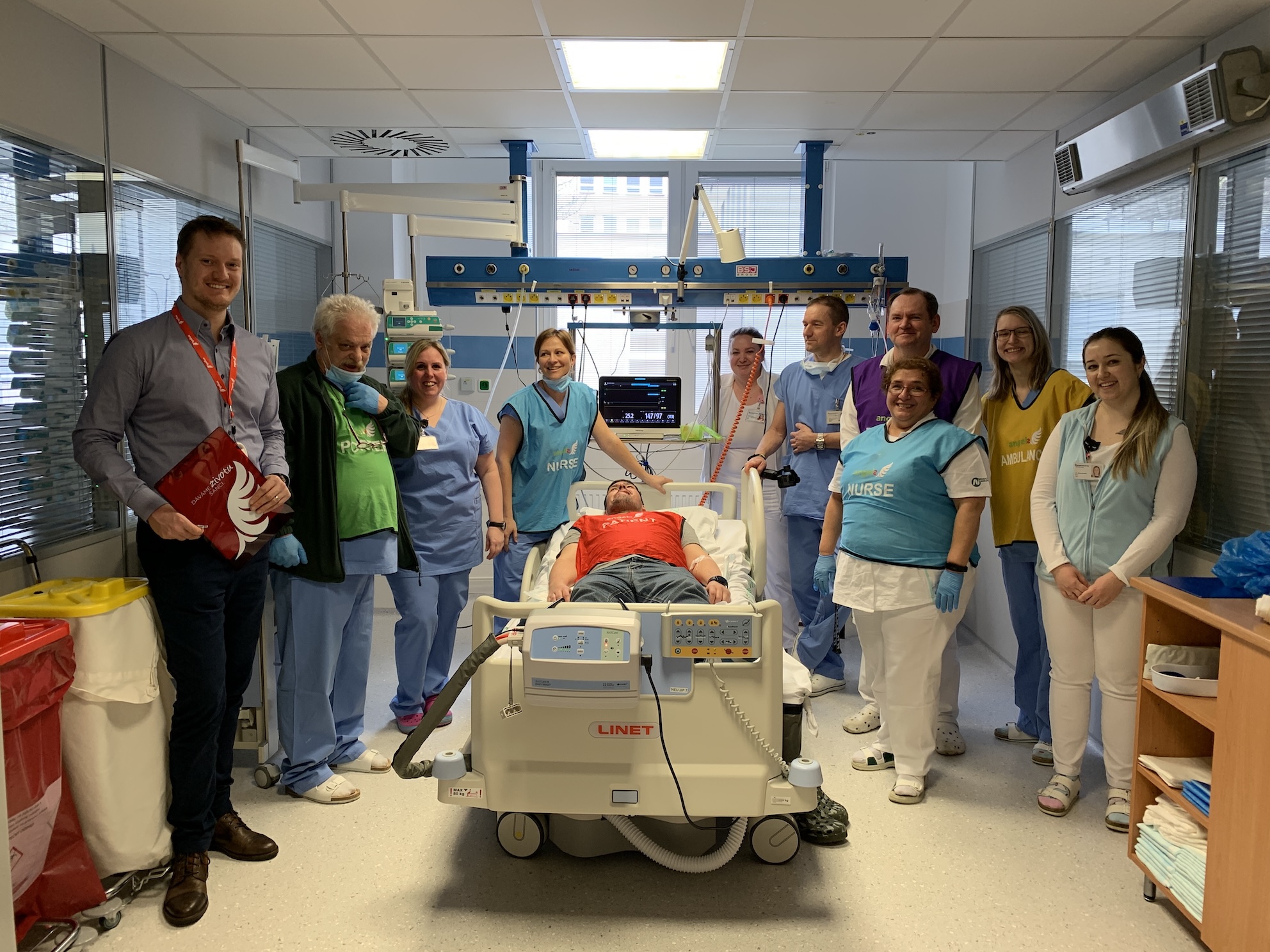พวกเขาไม่ใช่คนแรกในมาเลเซียที่รักษาผู้ป่วยโรคหลอดเลือดสมองด้วยการสลายลิ่มเลือด แต่พวกเขาเร็วที่สุดแล้ว

การรักษาการสลายลิ่มเลือดครั้งแรกที่โรงพยาบาล Tuanku Ja’afar ในเมืองเซรามบง (HTJS) เกิดขึ้นที่ 5 พฤษภาคม 2562 และทําได้ภายในเวลาไม่ถึง 60 นาที เป็นช่วงเวลาจากประตูจนได้รับการรักษาที่โรงพยาบาลหลายแห่งทั่วโลกจะรายงานด้วยความพึงพอใจแม้หลังจากประสบการณ์หลายปี แต่ไม่ใช่โรงพยาบาลรัฐอายุ 50 ปีในจังหวัดเนเกอริ เซมบลัง ซึ่งตั้งอยู่ทางชายฝั่งตะวันตกของคาบสมุทรมาเลเซีย
ภายในปี 2563 ทีมดูแลรักษาโรคหลอดเลือดสมองที่ HTJS ได้รักษาผู้ป่วยโรคหลอดเลือดสมองส่วนใหญ่ภายใน 45 นาที ในช่วงต้นปี 2021 ผู้ป่วยโรคหลอดเลือดสมองมากกว่าครึ่งหนึ่งได้รับการรักษาภายในเวลาไม่ถึง 35 นาที และในไตรมาสที่สอง เนื่องจากการแพร่ระบาดของCOVID-19 ครั้งที่สามที่สร้างความเสียหายได้เริ่มทําลายมาเลเซีย รางวัล WSO Angels Diamond Award เป็นก้าวสําคัญครั้งใหม่ ค่ามัธยฐานของระยะเวลาตั้งแต่ผู้ป่วยมาถึงโรงพยาบาลจนได้รับการรักษาระดับโลกอยู่ที่ 25 นาที
COVID-19 หยุดลงชั่วคราวเท่านั้น เนื่องจากจํานวนผู้ป่วยลดลงในช่วงเริ่มต้นของการระบาดใหญ่ แต่ภายในสิ้นปี 2021 ทีมดูแลรักษาโรคหลอดเลือดสมองที่ HTJS ได้ยืม rTPA จากรัฐใกล้เคียงเพื่อติดตามอัตราการทํางานของพวกเขา แม้จะมีการรวมโปรโตคอล Covid เพื่อปกป้องผู้ป่วยและตัวเอง แต่ระยะเวลาจากประตูจนได้รับการรักษาก็ไม่ได้สั่นสะเทือน
แพทย์ผู้เชี่ยวชาญด้านประสาทวิทยา ดร. Teh Pei Chiek และแพทย์แผนก ER ดร. Emi Noorina Binti Mohd Nor เล่าถึงวิธีที่โรงพยาบาลใช้เวลาในการรักษามากกว่าครึ่งหนึ่งภายในเวลาไม่ถึงสามปี ในขณะที่อัตราการเปิดหลอดเลือดเพิ่มขึ้นเป็นสองเท่า มีเรื่องประหลาดใจเล็กน้อย ในความเป็นจริงสิ่งที่พวกเขาแบ่งปันคือกรณีของตําราเรียนในการทําสิ่งที่สําคัญทั้งหมดอย่างถูกต้อง

ความต้องการความเร็ว
โรงพยาบาล Tuanku Ja’afar มีพื้นที่ 26 เฮกตาร์ใน Seremban เมืองหลวงของจังหวัดที่ตั้งอยู่ในหุบเขา Linggi River ห่างจากกัวลาลัมเปอร์ไปทางใต้ประมาณ 60 กิโลเมตร เดิมชื่อโรงพยาบาล Seremban General Hospital ได้เปลี่ยนชื่อในปี 2006 เป็นพระราชาคนที่สิบของมาเลเซียที่จะเสียชีวิตในโรงพยาบาลชื่อของเขาสองปีหลังจากป่วยด้วยโรคหลอดเลือดสมอง
ด้วยเตียง 1,143 เตียงและความเชี่ยวชาญทางคลินิก 23 สาขา HTJS ทําหน้าที่เป็นโรงพยาบาลส่งต่อผู้ป่วยสําหรับ Negeri Sembilan ทั้งหมด แม้ว่าอุบัติการณ์ของโรคหลอดเลือดสมองจะเพิ่มสูงขึ้นตามทั่วทั้งมาเลเซีย แต่โรงพยาบาลก็เริ่มรักษาโรคหลอดเลือดสมองเฉียบพลันหลังจากที่ได้รับบริการจากนักประสาทวิทยาในปี 2018 เท่านั้น
จากคํานี้ไป ดร. Teh ได้ใช้เวลาสั้นๆ ที่เป็นไปได้ตั้งแต่ผู้ป่วยมาถึงโรงพยาบาลจนได้รับการรักษา และได้อุทิศตัวเขาเองเพื่อขจัดอุปสรรคทีละข้อ นั่นคือ “ส่วนใหญ่” เขาอธิบาย “โดยการลบปฏิสัมพันธ์ที่ไม่จําเป็นทั้งหมดออกไปตลอดเส้นทาง”
ภายใต้การนําของเขาและด้วยการสนับสนุนจากดร. Emi โรงพยาบาลได้นําแนวทางใหม่ทั้งหมดมาใช้อย่างเป็นระบบสําหรับระเบียบการโรคหลอดเลือดสมองเฉียบพลัน ตั้งแต่การรวมบริการก่อนถึงโรงพยาบาลไปจนถึงการรักษาที่ CT
การแจ้งเตือนล่วงหน้าเป็นกุญแจสําคัญ และผู้ป่วยโรคหลอดเลือดสมองจะถูกส่งไปยังห้องภาพถ่ายเอกซเรย์คอมพิวเตอร์ โดยตรงซึ่งได้อ่านไว้ล่วงหน้าแล้ว การแจ้งเตือนโรคหลอดเลือดสมองเพื่อเรียกทีมสหสาขาวิชาชีพจะถูกเผยแพร่และบันทึกนาทีที่มีค่าโดยการดําเนินการหลายอย่างพร้อมกัน รวมถึงการประเมินความรุนแรงของโรคหลอดเลือดสมองและการขอความยินยอม
ความร่วมมืออย่างใกล้ชิดระหว่างประสาทวิทยาและรังสีวิทยาหมายความว่า ซีทีสแกนจะถูกแปลผลทันที ดังนั้นหากผู้ป่วยมีคุณสมบัติเหมาะสมในการสลายลิ่มเลือด การรักษาสามารถเริ่มได้โดยไม่ล่าช้า ระเบียบการ HASTE (Hyperacute Stroke Smart Track in Emergency) และชุด HASTE ของโรงพยาบาลเอง ซึ่งทั้งสองเกิดขึ้นจากการร่วมมือกับบริการ EMS ได้ชนะการแข่งขันนวัตกรรมแห่งชาติของมาเลเซีย แต่ที่สําคัญกว่านั้นก็คือ ด้วยการปรับปรุงเส้นทางบินให้มีประสิทธิภาพมากขึ้น พวกเขาจึงช่วยชีวิตผู้คนได้

การจัดการกับความท้าทาย
ความท้าทายต่อไปสําหรับ ดร. เตห์ และทีมของเขาคือการนําผู้ป่วยโรคหลอดเลือดสมองมาโรงพยาบาลได้เร็วขึ้น ปัจจุบัน มีผู้ป่วยเพียงประมาณหนึ่งในสามที่มาถึงโรงพยาบาลผ่านทาง EMS และอีกหนึ่งในสามที่ได้รับการแนะนําจากศูนย์อื่น ๆ หนึ่งในสาม อย่างไรก็ตาม เดินทางโดยไม่มีความช่วยเหลือและบ่อยครั้งเกินไปนอกกรอบเวลาการรักษา เป็นปัญหาที่สามารถแก้ไขได้ผ่านการรณรงค์ด้านสาธารณสุขเกี่ยวกับการรับรู้อาการของโรคหลอดเลือดสมองและการป้องกันโรคหลอดเลือดสมองเบื้องต้นเท่านั้น การป้องกัน
ทีม HTJS ยังมุ่งมั่นที่จะปรับปรุงบริการโรคหลอดเลือดสมองที่โรงพยาบาลอื่น ๆ ในภูมิภาค ซึ่งพวกเขาหวังว่าจะจําลองระเบียบวิธีของพวกเขาและแบ่งปันความรู้ของพวกเขา การฝึกจําลองสถานการณ์ที่โรงพยาบาลเขตใกล้เคียงอยู่ในวาระการประชุมอยู่แล้ว แม้ว่าโรงพยาบาลเพื่อนบ้านยังไม่ได้แต่งตั้งนักประสาทวิทยาก็ตาม
มาเลเซียประสบปัญหาการขาดแคลนผู้เชี่ยวชาญด้านการดูแลสุขภาพ รวมถึงในสาขาประสาทวิทยา เป็นวิทยากรในการประชุมโรคหลอดเลือดสมองครั้งแรกของมาเลเซียในปี 2019 อธิบดีกรมอนามัยดาตุค ดร. นอห์แฮม อับดุลลาห์ ประมาณการว่าจําเป็นต้องมีผู้เชี่ยวชาญด้านประสาทวิทยามากกว่า 200 คนเพื่อตอบสนองความต้องการของผู้ป่วยโรคหลอดเลือดสมองในประเทศ
ที่ HTJS ความมุ่งมั่นของดร. Teh ต่อทั้งประสาทวิทยาและผู้ป่วยของเขาแปลเป็นชั่วโมงการทํางานที่ยาวนาน แต่นักประสาทวิทยาคนที่สองมีความจําเป็นอย่างมากเพื่อให้ผู้ป่วยโรคหลอดเลือดสมองสามารถมั่นใจได้ถึงการรักษาที่ยอดเยี่ยมไม่ว่าจะเป็นชั่วโมงใด และดร. Teh จึงสามารถนอนหลับได้อย่างสนิท



